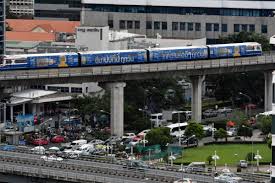Bangkok Skytrain


Bangkok Skytrain
The Bangkok Skytrain is Thailand's capital city's overhead railway system, most people just call it the
Skytrain, but the media usually refers to it as the BTS Skytrain (BTS stands for Bangkok mass-Transit System). In
Thai, it is called 'rot fai fa BTS'. It is run by the Bangkok Metropolitan Administration (BMA).
For ordinary Bangkokians, the Skytrain means no traffic jams, but for foreign tourists, it means a capital city
connection to international Suvarnabhumi Airport in about fifteen minutes instead of an hour by taxi. For everyone
it means an easy way of getting around in Bangkok.
The Bangkok Skytrain has made life so much easier for everyone using Bangkok, whether it be as a base or a home
and it hasn't ruined the taxi industry either, since the Bangkok Skytrain does not connect everywhere (yet),
although I do not know what plans there are to extend the present-day coverage of about 31km (20 miles).
There are 47 high-speed trains covering the two or three tracks, so the service is frequent enough and the
carriages are very comfortable, although they can become crowded during rush-hours, as one would expect. All in
all, the Bangkok Skytrain provides an excellent service at a very reasonable cost especially considering that the
alternative is a long wait in a smelly, polluted traffic jam.
The elevated Bangkok Skytrain offers splendid views of the city to its travellers to help them while away the
minutes as the train speeds them to their destination. The average speed of 35 kph - 21 mph (top speed 80 kph - 50
mph), may sound slow, but it is a lot faster than the average taxi can take you through the city centre.
Despite these benefits, the Bangkok Skytrain was not an immediate resounding success when it opened its doors
for business on the king's birthday (December 5th) 1999, since only about 200,000 tickets were sold per day at
first. This was barely enough to cover day-to-day operating costs and certainly did not cover investments loans and
profits.
However, as public confidence and acceptance in the Bangkok Skytrain grew, so did the number of tickets sold. By
2005, this had risen to 500,000 a day and in 2012 it was between 600,000 and 700,000 tickets a day. This all
between the hours of 06:00 and midnight.
At present, tickets can only be bought using coins,although change can be obtained from offices on the platform.
The company does, however, have plans to implement new methods of buying tickets in the near future involving smart
cards and RFID (radio frequency identification)
All of the systems stations have been well-thought out and follow a similar pattern, which is of three tiers.
The first, at road level, is for the heavy equipment which is necessary to run the station, and provides elevator
access to the second level, where one can buy tickets and light refreshments from machines and small kiosk-shops.
The third has the platforms for the trains. Route guides can be found at every level.
Consideration has been given to allow easy access to the trains for those in wheelchairs or carrying heavy loads
at all of the Bangkok Skytrain stations, so whether you are fit, but tired, sick, disabled or just a tourist laden
with heavy suitcases, you should have no problem boarding the Skytrain of your choice.
by +Owen Jones
| 







 Delicious
Delicious Digg
Digg Facebook
Facebook Google Bookmarks
Google Bookmarks Livejournal
Livejournal Reddit
Reddit Stumbleupon
Stumbleupon Twitter
Twitter